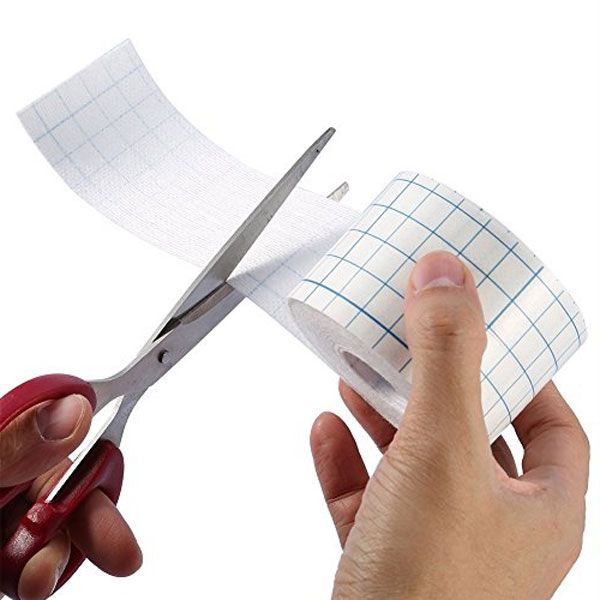Wound-Dressing

What is straw glue or hypoallergenic glue?
Straw glue is used to fix all kinds of dressings. This product does not irritate the skin and the patient is very comfortable with it. It is easy to use and even on uneven areas of the body, this dressing allows air and water vapor to pass through because of the use of soft, non-woven raw materials, and its hypoallergenic adhesive is very compatible with the skin.
Hypoallergenic adhesives can be easily removed from the skin without pain and leaving a residue. This product has excellent flexibility and can be used on the uneven surface of the body and joints without restricting body movements. Also, straw adhesives pass the radiation and there is no need to remove it during radiology.
Uses of straw glue:
- Ideal for keeping catheters and drains stable
- Ideal for covering non-adhesive dressings in all types of bedsores, diabetic and vascular wounds
- High elasticity, ideal for fixing dressings on joints and uneven areas of the body.
Advantages of hypoallergenic glue:
- High adhesive strength
- Compatible with body skin
- High flexibility
- High breathability (due to its wicker texture, gas exchanges are easily performed and it is permeable to air and water vapor)
- Increase the stability and tolerance of the skin
- It adheres well and is easily removed from the skin without leaving any residue
- Easy cut in different sizes
- Painless removal and replacement of adhesive
Panda straw adhesives are made in Iran and are completely hypoallergenic and available in the following sizes:
5 cm wide and 10 meter long straw adhesive roll
10 cm wide and 10 meter long straw adhesive roll
Rattan adhesive roll 15 cm wide by 10 meters long
20 cm wide and 10 meter long straw adhesive roll

What are the characteristics of straw glue?
1- It is lint-free:
Entry of any villi into the surface of the wound creates the possibility of infection. Therefore, the glue used for dressing should be free of any lint and extra fibers.
2- Having various dimensions and cutting the necessary amount of glue:
This adhesive, with perforations and adhesive separation lines, makes it very convenient for the consumer and eliminates the need to use scissors to remove the adhesive. It also has different lengths for different areas of the body. for example; For areas of the body, such as the waist, which has a wider surface, a larger width of mat glue should be used

3- It is not allergenic:
Non-allergenicity of wicker glue is another key feature of this glue. Wounds sometimes need to be closed for a long time, and if the adhesive cannot provide comfort to the patient, it can cause him discomfort. The acrylic layer on the surface of the straw glue has caused this glue to have no complications and allergies.
4- It passes through x-rays during photography:
Some adhesives do not have the ability to pass waves and radiations, and the adhesive must be opened before imaging; The straw glue passes the radiation and does not interfere during the imaging and radiology process.
5- It has many open pores:
This glue has a thin layer with many entry holes, which allows air and moisture to enter the skin pores and prevents sweating and heat inside the wound.
6- It has good adhesion:
Another important feature of wicker glue is its high adhesive strength and flexibility. This feature means that there is no need to worry about the glue separating after dressing. Wicker glue sticks well in all parts of the body, even in uneven areas of the body. Another thing that should be mentioned about these adhesives is that the straw dressing adhesive, despite its high adhesion, is easily removed from the skin and does not leave any traces, so it can be used in wounds such as wounds. Diabetes and bedsores, which open and close the tape, should be done slowly and carefully, the use of straw tape is acceptable and very useful.

Application of rolled straw glue:
Due to the strength and high adhesion of this glue, in cases where there is a need to fix wounds, such as wounds after surgery and fixing medical drains, you can use straw glue. Also, the use of this adhesive is very efficient for dressing diabetic wounds and bedsores.
What are the dimensions of straw glue?
In general, wicker glue is supplied in a roll of 10 meters in length and in different widths. Straw glue 5×10 (length 10 cm, width 5 cm), straw glue 10×10 (length and width 10 cm), straw glue 10×15 (length 10 cm, width 15 cm) and straw glue 20×10 (length 10 cm, width 20 cm)
How to use straw glue:
According to the cuts made in these adhesives, with the help of scissors, remove the desired amount from the roll. Remove the adhesive paper layer and place the adhesive on the wound.
tip : Avoid using straw glue for open wounds and burns because they are not sterile.
Wicker glue
What is straw glue?
Straw glue is usually used for dressing and post-operative care of wounds. Therefore, this type of glue is produced with special features. Rattan adhesives are produced from polyurethane and synthetic polyester materials that are lint-free and hypoallergenic. This type of adhesive is a thin and flexible layer just like fabric, which, despite being lint-free, has many small pores. These open pores are made to allow air, moisture and steam to pass through the adhesive layer, and in this way, it causes no sensitivity and scars on the skin, and the skin of the wound area is always dry and clean. In addition, the straw adhesive is made elastic and flexible so that the patient can move freely and easily and her function is not limited.
What are the characteristics of straw glue?
Since in many cases after surgery, it is necessary to take an image of the operated organ, these adhesives, which are used as a dressing holder, do not create an obstacle for the passage of the rays of imaging and radiology devices, and the doctor can easily position the Identify the operated member.
نوع پوشش چسب حصیری ساخته شده از الیاف غیر بافته (Non-woven) است و این امر سبب می شود که پوست حساس قسمت زخم یا عمل شده ی بدن، تحریک نشده و اثری بر آن باقی نماند. Also, this flexible and soft adhesive can be easily used in parts of the body that do not have a smooth and uneven surface. After use, you can easily remove the straw glue from it without causing excessive adhesion and pain and stretching the skin, and after removing the glue, no additional and sticky material remains on the skin.
Special design of straw glue
One of the distinctive points of straw adhesives is their special design. Due to the use of straw adhesives in dressings, etc., and in order to be able to use the amount required by the patient and according to the condition of the wound, it has also been produced in a roll form, and in this way, it can be easily applied to the required amount. cut it. For the easy and practical use of wicker glue, its protector is usually made in the form of a line so that the glue parts with standard dimensions can be easily separated and used.
What are the uses of straw glue?
This type of glue has many uses. For example, straw adhesives are used to keep different types of dressings stable, especially dressings after surgery. Also, straw glue is used to keep catheters and medical tubes, drains, etc. This type of adhesive is used for all types of bedsores and wounds of diabetic and vascular patients, which are non-adhesive dressings, due to the flexibility of the straw adhesive and its high adhesive properties.
Advantages of wicker glue
- – With open pores and the possibility of air, steam and moisture passing through
- – The use of non-woven fibers and as a result high flexibility and freedom of patient function and no skin irritation
- · –Using lint-free fibers and materials and thus being standard for wound dressing
- – The use of anti-allergic substances and ideal for sensitive skin in the wound area
- – High adhesion and ease of application and separation
- – Design in different dimensions, design in the form of a roll and design in the form of a line
- – The possibility of passing the rays of imaging and radiology devices




Leave a Reply